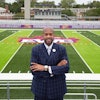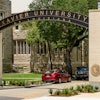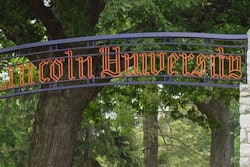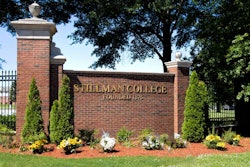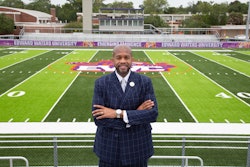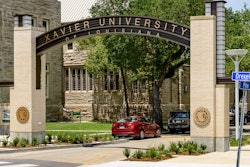AOL Time Warner Playing a Part in Bridging the Technology Gap
By Ronald Roach
DULLES, Va.
hen it comes to digital divide issues, B. Keith Fulton is one of the most recognized authorities in the United States. Fulton first came to prominence as director of technology programs and policy at the National Urban League in the early 1990s. Last April, Fulton became a vice president of the AOL Time Warner Foundation and a senior director for social innovations for the Corporate Relations division of AOL Time Warner Inc. Fulton is now charged with managing and developing domestic and international programs that promote digital opportunity. Fulton also works on communications and policy issues for AOL Time Warner.
Fulton’s key projects include: the Digital Divide Network — an online clearinghouse of information about the digital divide; the Education Technology Leadership Institute, which helps teachers gain skills to use technology effectively; PowerUP.org — a collaborative public/private venture to bring technology resources and skills to youth; and AOL Peace Packs — a program to equip Peace Corps volunteers with computers and Internet access.
BI: Several months ago, the AOL Foundation sponsored a digital divide conference that examined the gap in information technology resources and practices in use by historically Black colleges and universities (HBCUs) and the rest of higher education. Do you think a digital divide remains in effect in higher education?
FULTON: Higher education is broad. I think if we tried to say ‘let’s look at some measures of whether a given university is able to take advantage of the digital economy, the digital age for itself and its students — is it known for its leading edge-capabilities and how it delivers its instruction, etc.,’ you could definitely draw some distinctions between colleges and universities. One benchmark is the “Most Wired College” list, and I believe two HBCUs made the list last year — one being Tennessee State and the other being Hampton University…(Morehouse also made the list.) I’d like to see all the HBCUs on the list. And so I think there are some challenges. And to the extent we’re defining digital divide as the gap between those who have and those who don’t, then I think there is a substantial divide for some universities.
BI: In your opinion, why is it important to address the higher education digital divide?
FULTON: This information economy is driven by talented people, and at the end of the day companies need a strong pipeline. And schools will need to equip their students with the best tools, the best training, so that the students come out with the kind of skill sets that make them valuable in the marketplace. Higher education has been, for a very long time, part of the way that folks entered the economic mainstream. You go and get educated and enter the work force, and you’re right at middle class, or very quickly middle class, or above. In addition, as we think about schools as part of communities, I think that it’s important to make sure that schools can connect to each other and leverage each other’s educational capacity. Additionally, you want to have students being able to communicate with each other using e-mail. Professors being able to share lessons — things that work — over high-speed lines. You want to be able to connect alumni back to the schools. A lot of alumni are off and away — maybe in different states, maybe different countries. And the technology tools of today really do reduce the significance of those differences; reduce the cost of being able to share instructional design and pedagogy; reduce the reasons for these schools to not work together.
BI: Based on the work that you have done to explore the higher education digital divide, do you think there has been enough research and information collected to determine how significant the problem is?
FULTON: I was glad to see the UNCF (United Negro College Fund) study and the NTIA (National Telecommunications and Information Administration) study — I think they did that with NAFEO (National Association for Equal Opportunity in Higher Education). I think there probably needs to be more. We’re just really kind of getting an appreciation for what is going on in institutions. Very often, when you hear talk of digital divide, people usually focus on individuals. Accordingly, the poor, the disenfranchised, the least well-educated are the primary targets for programs. Well, we also have come to realize — and higher education institutions have been further along than some — that these institutions support people, support communities, train folks. If they’re not up to task, then it makes it very difficult for the end-product — the matriculated students — to be as potent a resource as they could be to support themselves, to support their communities or for the company that they go to. And so I think that institutions should be a part of gathering more research, producing the kind of institutional best practices and studies that help folks understand what the issues are and the opportunities.
That’s part of the reason why we developed our digital divide bridge grant. In short, it was to really understand some of the complex issues related to extending digital opportunity and to get a sense of what kinds of solutions made a difference. Probably the one, the most relevant, for the higher education community is the project we have under way with Tennessee State University. And really, that is to convene the leaders of the HBCU community to understand what kind of issues they face as they try to build their institutions in a digital age.
BI: Give some background on the digital divide conference that the AOL Time Warner Foundation underwrote with Tennessee State University?
FULTON: The mission of the AOL Time Warner Foundation is to use the power of media, communications and information technology to serve the public interest and to strengthen society. Within that, there are four priorities: 1) equipping kids for a better future; 2) extending Internet benefits to all; 3) engaging communities in the arts; and 4) empowering citizens and civic participation.
Our work in the digital opportunity portfolio falls under extending the Internet benefits to all. The Tennessee State grant is part of an effort to look at structural, pedagogical content and community values related to technology in the HBCU community and the use of the information and communications technology in the higher education community, particularly in the HBCU community. And Tennessee State came to us with a really strong grant — there were more than 900 applicants for this. We funded about 12 grants for about $1.5 million. Tennessee State received a grant to convene three to five regional conferences of leaders in the HBCU community. What we do is to develop a body of information informed by leaders as to what the core issues are and what kind of solutions are working. Hopefully, we can provide a roadmap for others who need the same kind of information. As HBCUs march toward the “Most Wired,” we would hope that this body of information that came out of this grant would be helpful.
BI: Do you think the higher education community is sufficiently engaged in the issue of the digital divide?
FULTON: I think there are several institutions of higher education that are playing leadership roles, and some of them are HBCUs — Howard, Hampton, Tennessee State, Florida A&M. …You’ve got schools that have been doing a lot of good and great work.
You’ve got these few that have been listed as being the “Most Wired,” so they’re doing what they need to do. You’ve got MIT that’s getting to do a big conference on the digital divide. Columbia’s Institute for Learning Technology and others have been pioneers and leaders, really. Collectively, these universities have given us some of the program logic that’s helped to extend the resources into the community. They’ve produced graduates who then go out and really take up these issues in a serious way. We anticipate working with the HBCU community to do more to produce talent to work in our industry, and to own and operate businesses.
BI: What are some other initiatives colleges and universities can undertake to close the digital divide?
FULTON: Students are the lifeblood of the college and university. The influx of bright, talented, motivated students is key to the survival of higher education. We’re in a period of history where one with certain certifiable skill sets can do as well as or better than someone with a college degree. So, it’s an interesting challenge for the higher education community to make sure that it continues to be relevant. I think that part of what colleges and universities can do to be relevant is to plug in their talented students as interns in companies, as volunteers in community-based programs to help some of the nonprofit institutions that support individuals and target digital divide programs.
We have a program called Tech Riders for example, where students from Virginia’s colleges — a good number of historically Black colleges and universities — go to AOL or to the Collis-Warner Foundation to get training. Then they go out to houses of worship throughout Virginia. They do 10 hours of training for seniors and youth. The Tech Riders teach trainees how to use computers, show them the Internet, answer whatever questions, expose them to some basic productivity programs and applications, and help them think through acquiring a computer. That program is demonstrating that knowledge transfer is good for the school the kid represents; it’s good for the community organization that’s trying to be a resource for its members, and it’s good for the student who gets a chance to apply some of the things they’re learning in the real world.
BI: How and why did you make the transition to AOL from the Urban League?
FULTON: Most people don’t know that I was at the National Urban League for so long — nine, almost 10 years. People began to associate me with being from New York, but I am actually from Virginia — born and raised in Hampton and Newport News. I went to undergraduate school in Virginia. I did graduate and law school in New York. And then I got connected with the League to head up their technology program and policy activities. But in coming home, first of all, to Virginia, and being with a company like AOL, and then AOL Time Warner, was really an opportunity to be associated with a great company — a company that would help me to take my work to another level. At the time I came into the company, AOL was the biggest Internet service provider (ISP) in the world. Now we’re the biggest media/communications company in the world. What’s more, the company has a very strong philanthropic mission. And so being associated with that, being able to help shape that, was important to me.
BI: What do you consider to be your main accomplishments at the National Urban League?
FULTON: When I took over technology programs and policy, about 3 percent of the “Movement” (the National Urban League and its 115 affiliates) as they called it, were using e-mail back in about 1994. There were no Web sites. There was no networked use of the Internet, or outside e-mail in the company. When I left, the national [office] had a Web site where you could search for jobs, interact with members of Congress and check out their Web sites. The league had broadcasted two conferences over the Internet, the first large civil rights nonprofit to do so. Ninety-seven percent of the Movement had e-mail; 50 percent had Web sites. The national office had T-1 [lines] with all staff having access to both the Internet and e-mail.
It was my privilege to help the organization move to another platform where it could leverage information technology tools to build its capacity to do its civil rights work. And so I feel good about my contribution. I go to the Web site today, and it’s the same navigation structure that I created before I left. I’m glad that it’s still useful to the organization.
BI: What other advice do you have for minority faculty, administrators and students who want to critically explore and participate in solving the digital divide problem?
FULTON: I definitely say we need their time and talent. There’s a lot of talented folks on campuses. As I said, students can volunteer as well as faculty. I think we shouldn’t leave out alumni because I think the alumni of HBCUs represent a tremendous interest group if we can engage them. And I think we might be able to do that with these technologies.
BI: What kinds of partnerships are AOL Time Warner and the foundation interested in
developing with higher education on digital divide issues?
FULTON: I think there are many partnerships. What’s critically important is creating community. This notion that the institution shouldn’t be isolated from the community, the residents and other organizations in the community is really important. We talked about how that happens, the volunteering, the mentoring, etc. I think, also, we’d like to make sure that the work-force pipeline remains strong, and folks coming out of institutions of higher education have relevant skill sets. That means internships, that means industry partnering with higher education to frame programs and course offerings that will help prepare the students for what industry needs them to do. Then finally, there is a real opportunity to lift up the voice of HBCUs. I think schools like Howard, Hampton, Morehouse, Tennessee State and some others have a real opportunity to provide a leadership role in helping HBCUs to be a substantial contributor to the IT [Information Technology] work force even more so than they are today.
BI: How important is the work-force development issue to AOL Time Warner?
FULTON: It’s definitely one of our corporate aspirations to draw from talent wherever it may be and to help to develop it when we can. You should anticipate from our programs that [we’ll] try to leverage the HBCU community, the programs that we work with and the higher education community generally. There are programs where we try to seed opportunities for small businesses or minority and women-owned businesses to connect with venture capitalists, and also a ratcheting up of our various supplier programs — and I might add our award-winning supplier programs.
BI: Will there be more opportunities for schools to compete for grants?
FULTON: We probably won’t do the digital divide bridge grant program next year. It was really a laboratory for us to understand what some of the issues were or what some of the solutions might be. We definitely will continue to work with institutions of higher education, especially the HBCUs broadly and in some unique project with one or two schools playing a leadership role. That’s what our intentions are right now.
Related Story
Historically Black Colleges Strive to Bring Campus Communities Up to Technological Speed
© Copyright 2005 by DiverseEducation.com



